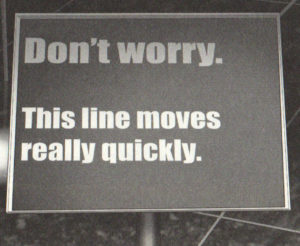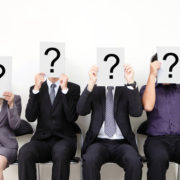Supercharge Your Persuasive Power by Saying What Your Customer is Thinking
“THAT’S the line? Are you kidding me?!?”
This was my ongoing inner monologue on a family vacation to one of the many world-class theme parks in beautiful Orlando, Florida. Indeed, huge lines for popular attractions are an unfortunate and unavoidable part of the experience. And as a father of three, I’ve proudly stood in my share of them. But on this trip, something strange happened during the wait for one particular ride.
As I snaked through the seemingly endless line for a Simpsons- themed ride at Universal Studios, I grew increasingly frustrated, thinking, “How much longer is this going to take?!” Then I walked past this sign:

I immediately had a brief chuckle. Then I started to relax. My demeanor softened and a smile came to my face. They got me! They understood what I was going through. They crystallized the narrative that had been running through my head…and wouldn’t you know, it made me feel better.
In his bestselling book (and one of my top sales reads), To Sell Is Human, author Dan Pink shared a similar story. On a family visit to a New York City museum, his kids reported feeling hungry, resulting in the discovery of an anaconda-sized line in the sole-source museum cafeteria. But moments later he saw this sign, and it similarly transformed his experience.

What is it about reaching into someone’s subconscious, labeling what they’re thinking or feeling and showing it to them, that’s so powerful?
Former FBI international hostage negotiator, Chris Voss, discusses this fascinating labeling tactic in his book, Never Split the Difference. In it, Voss references a University of California, Los Angeles, brain imaging study that found when people are shown photos of faces expressing strong emotion, the images show greater activity in the amygdala, the part of the brain that generates fear. But when the subjects are asked to label the emotion they’re seeing, the activity moves to the area that governs rational thinking. In essence, the labeling and articulation of the feeling itself disrupts its intensity!
Imagine walking into a doctor’s office with a peculiar and highly uncomfortable rash on your leg. You’ve had it for four days already and aren’t sure what it is. You’re concerned and a little scared. Suppose that your doctor took one look at it and said, “Let me guess, it burns in the morning and itches in the afternoon?”. “Yes!”. “Did you by any chance visit a farm in the past week?”. “Oh my goodness, yes I did!”. “I thought so. Don’t worry, it’s an allergic reaction to a specific type of rural pollen that’s especially prevalent this time of year.” After hearing the doctor continue and say, “Don’t worry…you’re the 5th person I’ve seen this week with the same”, chances are you would immediately relax and your fear dissipates shortly thereafter.
Here are some ways you can apply the amazingly powerful principle of labeling in your sales cycle.
1. Discovery
One of the primary objectives of good discovery is to understand your customer’s environment and the challenges they’re experiencing. Equally as important is demonstrating that you have the ability to help them. The labeling technique can go a long way here.
Imagine you were conducting discovery with a prospective customer. As you drive the conversation forward, one of the things you might say is:
“I speak to customers in your position every day and the number one challenge I hear from them is _________”.
Now imagine your brilliant synthesis was not only accurate but shared either at the outset of the conversation or after the customer had shared a few disparate insights about their current environment. Not only are you likely to hear a “that’s right!” (or equally powerful confirmatory reaction) from your customer, but the act of labeling will create both strong resonance with your message and alignment with your solution.
Bonus exercise: sitting down with key members of your sales, marketing, success, and product teams to align yourselves around these customer-centric pain statements is a worthwhile activity! To help drive your discovery conversations forward you may even want to position your message as “the top three things” instead of the one thing and let your customer pick which one resonates most deeply.
Check out these short videos on how to use this powerful labeling technique.
2. Objection Handling
As you’ve already seen from the first two stories in this article, one of the most powerful applications of labeling is addressing potentially contentious issues stirring around in your customer’s head. If you know that nine times out of ten your customer will raise an issue, especially if the issue is likely to manifest as an unspoken objection, you’d be well served to preempt it with a well-articulated label.
For example, suppose you were in the market for a new suit. Browsing the rack and inspecting the prices on your own, you’d likely assign your own labels to the merchandise; categorizing suits as either “expensive” or “affordable”. However, suppose the salesperson preempted your browsing by saying something like, “Now as you look through the rack, you might find that some of these suits cost a little more than you had planned on spending. But what most of my clients eventually find is that not only do they feel more confident wearing the higher-end garments to important meetings and events, but the high quality means they last a lot longer than the less expensive suits”.
Chances are you’d feel less apprehensive about considering the higher-priced items as you browsed. In fact, this objection-handling technique is known as inoculation which you can learn more about in the short video below:
3. Negotiation
Like most objections, often times when customers vocalize issues during a negotiation, they state the surface level problem without revealing the root cause or underlying intent (which is the real issue you need to address).
For example, during a negotiation, a customer might say that while they see the value of your solution, the annual, up-front cost you’re asking for is too expensive for them. In that case, you may decide to label their concern by saying something like, “It sounds like you see the value in our solution but feel the payment structure doesn’t work with the cash flow model of your business.” Once the customer ideally affirms your labeling of the situation with an emphatic “that’s right!”, they’ll be more receptive to you positioning an alternative payment structure that more closely aligns with theirs.
Science has shown that reaching into the mind of your customer, synthesizing their thoughts, and labeling them can be one of the most powerful persuasive techniques! This is especially true when those thoughts go unspoken or when the customer isn’t able to articulate them themselves. By looking for opportunities to this technique, you’ll be able to invoke more empathy in your customer interactions, reduce your buyer’s fears, and build strong affinity with your brand in the process.
We promise never to send you junk or share your email! Just helpful sales insights.














Leave a Reply
Want to join the discussion?Feel free to contribute!